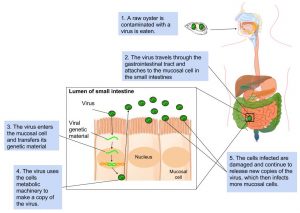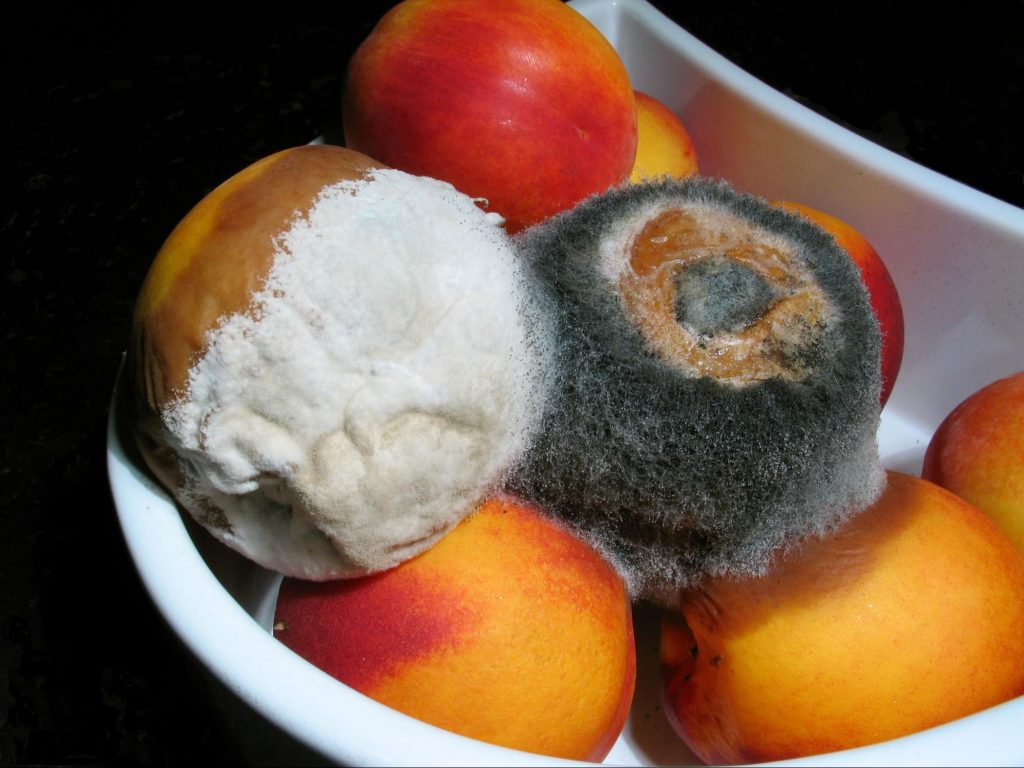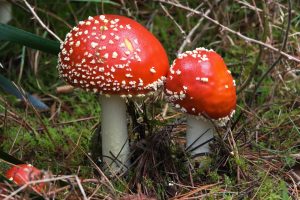Unit 1 – Food Safety
1.7 Biological Contaminants in Foods
Both foodborne infections and foodborne toxins can create a burden on food systems, when companies must recall contaminated food and on the health-care system, where infected individuals must be treated. It all begins when a person ingests a food contaminated with pathogenic microbes (germs), and the microbes travel to the stomach and intestines. There, the live microbes can grow and eventually interfere with the body’s functions and make you sick. This section will focus on different types of common microbes that can cause food infections and intoxications, including bacteria, viruses, parasites, and fungi.
About one hundred years ago, typhoid fever, tuberculosis, and cholera were common diseases caused by contaminated food and water. Over time, improvements in food processing and water treatment eliminated most of those problems in North America. Today, other bacteria and viruses have become common causes of food infections, as summarized by CDC in “Food-Borne Causing Microorganisms in the US.”
Bacteria
All foods naturally contain small amounts of bacteria. However, poor handling and preparation of food and improper cooking or storage can cause bacteria to multiply to a level that will cause food poisoning. In addition, bacteria can multiply quickly when cooked food is left out at room temperature for more than a few hours. Most bacteria grow undetected because they do not change the color or texture of food or produce a foul odor. Freezing and refrigeration slow or stop the growth of bacteria but do not eradicate the bacteria. The microbes can reactivate when the food is taken out and thawed. Warmer weather and unrefrigerated foods create ideal conditions for bacteria to grow.

SALMONELLA One of the most common pathogenic bacteria is Salmonella, found in the intestines of birds, reptiles, and mammals. They were first discovered by scientist Dr. Daniel E. Salmon in 1885 and named after him. Salmonella can spread to humans via animal-origin foods, including improperly cooked meats, poultry, eggs, dairy products, and seafood. The disease it causes, salmonellosis, typically brings about fever, diarrhea, and abdominal cramps within twelve to seventy-two hours after eating. Usually, the illness lasts four to seven days, and most people recover without treatment. However, Salmonella can invade the bloodstream in individuals with weakened immune systems and lead to life-threatening complications, such as a high fever and severe diarrhea.[1]
LISTERIA MONOCYTOGENES You might have heard of “listeria hysteria” caused by the bacterium Listeria monocytogenes, found in soft cheeses, unpasteurized milk, meat, and seafood. Consuming contaminated food causes listeriosis, resulting in fever, headache, nausea, and vomiting. Listeria primarily affects pregnant women, newborns, and older adults. [2]
ESHERRICHIA COLI, The most common sources of E.coli, are raw or undercooked meat, raw vegetables, unpasteurized milk, minimally processed ciders and juices, and contaminated drinking water. Symptoms include watery and bloody diarrhea, severe stomach cramps, and dehydration. Perhaps the most serious is neurological complications and stroke. An E. coli infection can cause kidney failure and death in young children. Additionally, E. coli produces the Shiga toxin, a substance not destroyed by heat.
CLOSTRIDIUM BOTULINUM This bacterium produces a toxin that causes botulism, a rare but deadly condition. Home-canned foods are the most common source of the deadly toxin; it rarely occurs in commercially prepared ones. An infected person may experience symptoms within thirty-six hours after eating. Symptoms include nerve dysfunction, such as double vision, inability to swallow, speech difficulty, and paralysis of the respiratory system. Botulism is the most fatal of all foodborne illnesses, especially among infants.
CLOSTRIDIUM PERFRINGENS The CDC estimates this bacteria causes nearly 1 million illnesses in the United States every year, especially around the holidays. Primary sources of infection include meat, poultry, gravies, and other foods cooked in large batches and held at an unsafe temperature. Outbreaks tend to happen in places that serve large groups of people, such as school cafeterias and catered events. C perfringens is not deadly like C botulinum.
CAMPYLOBACTER JEJUNI Campylobacteriosis is the most commonly identified bacterial cause of diarrhea worldwide. Consuming undercooked chicken, or food contaminated with raw chicken juices, is the most frequent source of this infection. Within two to five days after consumption, symptoms can begin, including diarrhea, stomach cramps, fever, and bloody stools. The duration of this disease is about seven to ten days.
STAPHYLOCOCCUS AUREUS About thirty percent of the population carry Staphylococcus aureus (Staph) in their noses. Food handlers who sneeze or rub their noses without washing their hands may contaminate food with Staph. If food is contaminated with Staph, the bacteria can multiply in the food and produce toxins that can make people ill. Cooking kills Staph, but the toxins they produce are not and can still make you sick. Symptoms can begin thirty minutes to eight hours after eating contaminated foods and include diarrhea, vomiting, nausea, stomach pain, and cramps. This food infection usually lasts one to two days.
Probiotics: HealthY Bacteria

Image by Gabriel Lee / CC BY-NC
Probiotics and prebiotics are hot topics in the mainstream media. The World Health Organization (WHO) defines probiotics as live bacteria that confer beneficial health effects on their host. They are sometimes called “friendly bacteria.” The most common bacteria labeled probiotics are lactic acid bacteria (lactobacilli). These live cultures are in certain fermented foods such as yogurt.
Prebiotics are indigestible foods, primarily soluble fibers, that stimulate the growth of certain strains of bacteria in the large intestine and provide health benefits to the host. A review article in the June 2008 issue of the Journal of Nutrition concludes that there is scientific consensus that probiotics ward off viral-induced diarrhea and reduce the symptoms of lactose intolerance.[3]
Most nutritionists agree that more health benefits of pre- and probiotics will likely reach scientific consensus. As the pre- and probiotic manufacturing fields and their clinical study progress, more information on proper dosing and what exact strains of bacteria are potentially “friendly” will become available.
You may be interested in trying some of these foods in your diet. A fermented dairy food to try is kefir. Several websites provide good recipes, including http://www.kefir.net/recipes.htm.
Viruses
Viruses are another type of pathogen that can lead to food infections, however they are less predominant than bacteria. Viruses differ from bacteria in that they cannot grow and reproduce in foods. Instead, viruses that cause human diseases can only reproduce inside human cells ( See Figure 1.1 “Viruses in the Human Body”). Hepatitis A is one of the more well-known food-contaminating viruses. Sources include raw shellfish from polluted water, and food handled by an infected person. This virus can go undetected for weeks, and, on average, symptoms do not appear until about one month after exposure. At first, symptoms include malaise, loss of appetite, nausea, vomiting, and fever. Additional symptoms can manifest three to ten days later, including jaundice and darkened urine. Severe cases of hepatitis A can result in liver damage and death.

Figure 1.1 Viruses in the Human Body Image by Allison Calabrese / CC BY 4.0
The most common form of contamination from handled foods is the norovirus, also known as the Norwalk-like virus. Sources include raw shellfish from polluted water and any food handled by an infected person. The norovirus causes gastroenteritis, and within one to three days, it leads to symptoms, such as nausea, vomiting, diarrhea, stomach pain, headache, and a low-grade fever.[4]
Parasitic Protozoa
Food-contaminating parasitic protozoa are microscopic organisms spread in food and water. Several of these creatures pose significant problems to food production worldwide. They include Anisakis, tiny worms that invade the stomach or the intestines. This parasite can result in the Anisakis infection, with symptoms that begin within a day or less and include abdominal pain, which can be severe. Sources of this parasite include raw fish.
Cryptosporidium lives in the intestines of infected animals. One major problem with this pathogen is highly resistant to disinfection with chlorine. After heavy rains, another common source is drinking water and washing animal wastes into reservoirs. Cryptosporidium causes the disease cryptosporidiosis. Symptoms begin one to twelve days after exposure and include watery stools, loss of appetite, vomiting, a low-grade fever, abdominal cramps, and diarrhea. The disease can be severe for HIV/AIDS patients and others with weakened immune systems and sometimes can lead to death.
Giardia lamblia is another parasite that is found in contaminated drinking water. In addition, it is located in feces and commonly spread in daycare centers due to inadequate handwashing after changing diapers and toileting practices. Giardia causes giardiasis, with symptoms that include abdominal cramping and diarrhea within one to three days. Although most people recover within one to two weeks, some continue having symptoms much longer.
The parasite Toxoplasma gondii causes the infection toxoplasmosis, a leading cause of death attributed to foodborne illness in the United States. More than sixty million Americans carry Toxoplasma gondii, but few have symptoms. Typically, the body’s immune system keeps the parasite from causing disease. Sources include raw or undercooked meat and unwashed fruits and vegetables. Handling a cat’s feces with an acute infection can also lead to the disease.[5]
Mold Toxins
Molds are microscopic fungi can grow on fruits, vegetables, grains, meats, poultry, and dairy products. They typically appears as gray or green “fur.” Warm, humid, or damp conditions encourage their growth.

Moldy nectarines by Roger McLassus 1951 / CC BY-SA 3.0
Unlike single-celled bacteria, molds are multicellular and look like slender mushrooms under a microscope. They have stalks with spores that form at the ends. The spores give molds their color and can be transported by air, water, or insects. Spores also enable mold to reproduce. Additionally, molds have root-like threads that may grow deep into the food and be difficult to see. The threads are very deep when a food shows heavy mold growth. Foods that contain mold may also have bacteria growing alongside them.
Some people wonder if it’s safe to eat moldy food if you cut off the moldy portion. According to USDA, it’s not.
No, you only see part of the mold on the surface of food — gray fur on forgotten bologna, fuzzy green dots on bread, white dust on Cheddar, coin-size velvety circles on fruits, and furry growth on the surface of jellies. When a food shows heavy mold growth, “root” threads have invaded it deeply.
In dangerous molds, poisonous substances are often contained in and around these threads. In some cases, toxins may have spread throughout the food. [6]
Like the kind found in blue cheese, some molds are desirable in foods, while other molds can be dangerous. The spores of some molds can cause allergic reactions and respiratory problems. In the right conditions, a few molds produce mycotoxins, which are natural, poisonous substances that can make you sick. Mold threads contain mycotoxins and, in some cases, may have spread throughout the food. The Food and Agriculture Organization of the United Nations estimates that mycotoxins affect 25 percent of the world’s food crops.[7] They are found primarily in grains and nuts, but other sources include apples, celery, and other produce.
Aflatoxins are the most dangerous mycotoxins. Strains of fungi called Aspergillus produce aflatoxins in hot, humid weather. Symptoms include vomiting and abdominal pain. Possible complications include liver failure, liver cancer, and even death. Many countries try to limit exposure to aflatoxins by monitoring their presence on food and feed products.
Poisonous Mushrooms

Like molds, mushrooms are fungi, and the poisonous kind produces mycotoxins that can cause food intoxication. Toxic mushrooms, also known as toadstools, can cause severe vomiting and other symptoms. However, only a few varieties are fatal. Toxic mushrooms cannot be made safe by cooking, freezing, canning, or processing. The only way to avoid food intoxication is to refrain from eating them. Mushroom guides can help wild gatherers distinguish between the edible and toxic kinds[8].
Review Questions
Attributions:
- University of Hawai‘i at Mānoa Food Science and Human Nutrition Program, “Human Nutrition ” CC BY-NC 4.0
- Salmonella. Centers for Disease Control and Prevention. http://www.cdc.gov/salmonella/. Updated June 25, 2021. Accessed July 16, 2021. ↵
- Listeria Moncytogenes Centers for Disease Control and prevention https://www.cdc.gov/foodsafety/diseases/clostridium-perfringens.html Updated May 18, 2021. Accessed July 16, 2021 ↵
- Farnworth ER. The Evidence to Support Health Claims for Probiotics. J Nutr. 2008; 138(6), 1250S–4S. http://jn.nutrition.org/content/138/6/1250S.long. Accessed September 22, 2017. ↵
- Foodborne Illnesses and Germs. Centers for Disease Control and Prevention.https://www.cdc.gov/foodsafety/foodborne-germs.html . Updated January 23, 2018. Accessed June 28, 2021. ↵
- Centers for Disease Control and Prevention. “Parasites.” Last updated September 18, 2020. https://www.cdc.gov/parasites/index.html . ↵
- United States Department of Agriculture. "Molds on Foods. Are They Dangerous? https://www.fsis.usda.gov/food-safety/safe-food-handling-and-preparation/food-safety-basics/molds-food-are-they-dangerous. Updated August 21, 2023. Accessed July 16, 2021. ↵
- Eskola, Mari et al. "Worldwide contamination of food-crops with mycotoxins: Validity of the widely cited 'FAO estimate' of 25." Critical reviews in food science and nutrition vol. 60,16 (2020): 2773-2789. doi:10.1080/10408398.2019.1658570 ↵
- US Department of Agriculture, Food Safety and Inspection Service. “Molds on Food: Are They Dangerous?” Last modified August 23, 2013. http://www.fsis.usda.gov/FactSheets/Molds_On_Food/. ↵
Inflammation of the stomach and bowels caused by microbial contamination of foods or beverages.
Inflammation of the stomach and bowels that results after consuming a food or beverage that is contaminated with a toxin.
Food production, processing, distribution, consumption and
disposal of foods. Also known as food chain.
Another term for the four disease causing microorganism categories: bacteria, viruses, fungi, and protazoa.
The temperature range that most people feed comfortable, generally between 65 to 80 degrees fahrenheit.
Lowering the temperature of a food to below 32 degree.
Home freezers shoudl be kept below 0 degree fahrenheit.
Illness that develops after eatin a food contaminated with Clostridium botulinum.
A poison, often produced by bacteria, viruses, or molds in foods. Eating a food contaminated with a toxin results in food poisoning.
Live bacteria consumed in a product that is introduced to the body and lives temporarily in the colon and confers health benefits to the host.
Indigestible foods, primarily soluble fibers, that stimulate the growth of certain strains of bacteria (probiotics) in the large intestine and provide health benefits to the host. (Prebiotics serve as foods source for probiotic bacteria.)
Live bacteria consumed in a product that is introduced to the body and lives temporarily in the colon and confers health benefits to the host.
Sources of food for probiotic bacteria that promote health.
The enzyme needed to digest the lactose in milk. Also known as milk sugar.
An very small infectious agent that can multiply only in living cells of animals, plants, or bacteria, such as the coronavirus, or those that cause flu and colds.
Mold is a species of fungi.
Kingdom: Fungi Species: mold
The kingdom the molds and yeasts are a species under
Any toxic substance produced by a fungus.

